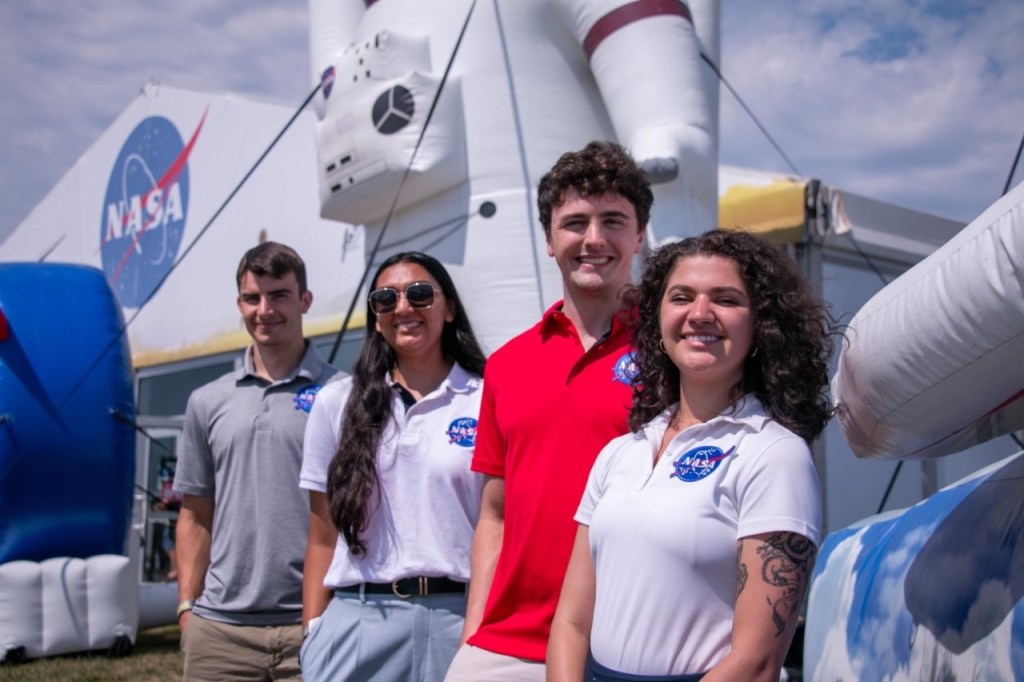Jim Sokolik recently became the man who launched 1,000 ships.
Well, not exactly sea-going ships. Sokolik reached his personal milestone by launching his 1,000th mission when one of the two ER-2 aircraft that NASA Dryden Flight Research Center operates for NASA’s high-altitude science program took to the sky in mid-September.
Sokolik, a member of Dryden’s high-altitude life support team, maintains and prepares the full-pressure suits pilots wear on all high-altitude missions. He often works through an entire mission, from the initial flight briefing to the recovery of the mission aircraft.
A resident of Rosamond, Sokolik joined NASA in August 1987 when the program was based at NASA’s Ames Research Center near San Jose, and followed the ER-2 when it was relocated to Dryden in 1997.
For more than 19 years he has prepared pilots for missions around the world, but some of his most invigorating deployments are those where he can share his infectious enthusiasm with the next generation of explorers, scientists and technicians.
“I enjoy talking to groups of 10- to 12-year-olds because they’re usually the most receptive and ask the best questions,” Sokolik said. “About once a year, a question is phrased in such a way that when I start to answer, I have to stop and rethink what I was going to say because the standard answer isn’t going to do it. Those are the moments I really like.”
Sokolik loves to satisfy students’ curiosity and enjoys fueling it by talking to them about the Gore-Tex material of the pressure suits. That usually leads to a discussion about the size of molecules and follow-on conversations about how air pressure affects the human body at different altitudes. Topics that touch on chemistry, science and mathematics are always part of his presentations, which he uses to inspire and challenge kids to tap their sense of curiosity for learning about subjects that could lead to rewarding careers as well as to identifying potential solutions to problems.
During his tenure with NASA, Sokolik has been part of a five-man life support shop and has also, at times, been an army of one. Preparing the equipment, pilot and plane for a mission is exciting and hard work, but it’s all worth it when the plane gets airborne.
Before coming to Dryden, he served eight years in the Air Force, five of which were spent working with high-altitude aircraft. During that stint he worked as a member of a large life support group that prepared the Lockheed U-2S “Dragon Lady” spy plane for its missions. NASA’s ER-2 is a civil version of the U-2S.
The size of the ground crew points up a key difference between the Air Force and NASA life-support operations, Sokolik said. While at NASA it is a start-to-finish operation, Air Force work is more specialized – one person would prepare the flight suits, another would prepare and launch the aircraft, and still another would recover it.
“With NASA there’s more of a one-on-one rapport and a greater sense of accomplishment,” he said. “When the pilot comes back at the end of the day and says everything worked well and he thanks the crew, we all know he means it.”
Sokolik has traveled extensively on ER-2 deployments, including missions in Australia, New Zealand (twice), South Africa, Brazil, Sweden, Fiji, Alaska, Hawaii (three times) and many stateside locations in support of environmental research.
“Some of the best experiences have been seeing and interacting with other cultures while traveling. I’ve given fire department briefings and demonstrations to visiting dignitaries where an interpreter was required, and sometimes I’ve demonstrated the pressure suit to people in situations where there was no common ground other than curiosity,” he said.
ER-2 missions begin with briefings the day before and the day of a mission. It then takes about 90 minutes to help the pilot put on the flight suit, complete the pressure and communication checks on the equipment and be transported to the aircraft. When the pilot climbs aboard, Sokolik leans over the cockpit and helps him connect the suit to the aircraft life support systems.
“I hook them up to the airplane because (pilots) lack the dexterity and vision to do it themselves when they are suited up,” he explained.
Next the aircraft taxis to an area called “last chance” – where final checks are made – and then it’s time to fly. Pilots take great pride in their takeoffs and know the ground crew is always expecting a good show, Sokolik said, but for him the takeoff is music to his ears.
“If a takeoff wasn’t such a sight to behold, I would just close my eyes and listen to it.”
At the end of a flight, which can last eight or more hours, the aircraft lands and Sokolik or another member of the life support team unhooks the pilot from the aircraft and secures the ER-2’s life support systems.
Sokolik values his job, his crew and the pilots he works with.
“I work with a great group of people and every launch is truly a team effort across the board,” he said. “Everybody helps everybody, and that’s what makes it all work.”
-0-
PHOTO EDITORS: High-resolution photos to support this release are available electronically on the NASA Dryden web site at: http://www.dfrc.nasa.gov/Gallery/Photo/ER-2/index.html . Recommended photos include #ED00-0037-27, ED00-0037-33 and ED06-0117-13.
For more information about NASA Dryden Flight Research Center and its research projects, visit: https://www.nasa.gov/centers/dryden on the Internet.
– end –
text-only version of this release
To receive status reports and news releases issued from the Dryden Newsroom electronically, send a blank e-mail message to dfrc-subscribe@newsletters.nasa.gov. To unsubscribe, send a blank e-mail message to dfrc-unsubscribe@newsletters.nasa.gov. The system will confirm your request via e-mail.
Dryden Flight Research Center
P.O. Box 273
Edwards, California 93523
Phone 661/276-3449
FAX 661/276-3566
Alan Brown
NASA Dryden Flight Research Center
Phone: 661/276-2665
alan.brown@dfrc.nasa.gov
























